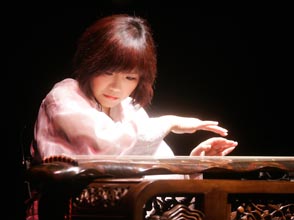Listen
Related Essays
The Dong Singers

Though perhaps more famous for its cultivated singing styles, China is also rich in a wide range of traditional folk song. Common among the Han (comprising more than 90 percent of the population), as well as China’s various minority populations, is a long history of unaccompanied—or lightly accompanied—singing directly connected to various rituals of life and calendar events.
The Dong people, one of China’s 55 acknowledged non-Han minorities, have long been considered one of the nation’s most musical minorities. Numbering more than 2.5 million, the Dong live mainly in the Guizhou, Hunan, and Guangxi provinces in southwestern China, maintaining a way of life geographically and culturally removed from the Chinese mainstream.
Both solo and communal singing has long been an active part of Dong life, from casual drinking songs to formal gate-barring rituals—a 1,000-year-old tradition where festive-clad villagers confront prospective visitors with local rice wine to ensure that their intentions are peaceful.
In any case, what has made the vocal tradition particularly important to the Dong has been the people’s lack of a written language. Until the 1950s, when the Chinese government imposed pinyin Romanization on their spoken language, the Dong had remained a strictly oral culture.
Dong singing remains most distinctive today in its ensembles called da ge (or “big song”), named not for a song’s duration, but for the forces required. Though much of the texture is in unison—especially in children’s choruses—the most characteristic sonorities emerge from Dong polyphony, where techniques of sound imitation feature singers vividly illustrating the sounds of nature. From pipa ballads and hearty drinking songs to solemn historical narratives and courtship rituals, Dong music still recalls a pre-literate culture in which every aspect of life was expressed in song.
The Qin Zither: Solo Music of the Literati

In contrast to the noise and bustle created by other folk instruments, the seven-string plucked zither known as the qin (or guqin) has an intimate feel and a prestige that far outweighs its tiny minority of players. In ancient China the qin was an essential component of the culture of the imperial literati, along with chess, calligraphy, painting, kunqu opera, and the pipa, or plucked lute. The qin’s scholarly detachment and union with nature have made it a favorite subject of poets and painters for over 1,000 years. Though still studied by conservatory students as well as amateurs, it can most typically be found at gatherings of aficionados, who take turns playing while sipping fine tea and admiring paintings, calligraphy, and exquisite old instruments. In recent years the qin has gained a new global life in concerts, CDs, films, and on the internet, and new players have emerged to replace the generation of older masters who kept the qin alive through the troubled years of Maoism.
The structure of the instrument has changed little during the past 2,000 years; however, the majority of works performed on it today date back only a few centuries. The contrast in timbre created by such effects as open strings, stopped pitches, expressive slides, and ethereal harmonics creates a mesmerizing soundscape: The ebb and flow of free tempo often confounds any sense of metre. Though soft in dynamic, the qin is capable of a wide range of expression: In addition to meditative, it can sound zany, inebriated, or even violent. Notation, otherwise of minor importance in most Chinese genres, has a long tradition in the case of the qin, which requires a complex system of tablature.


